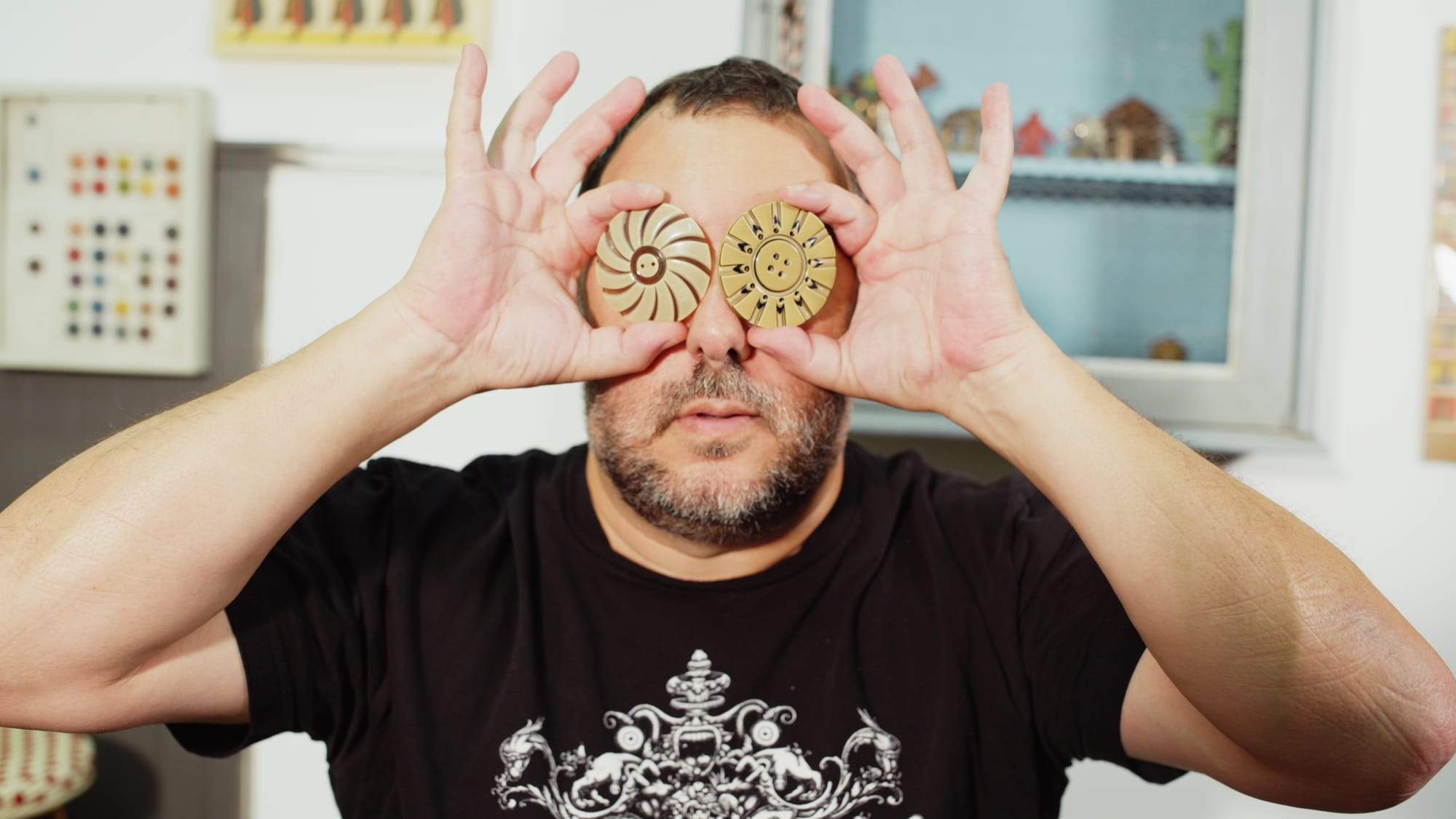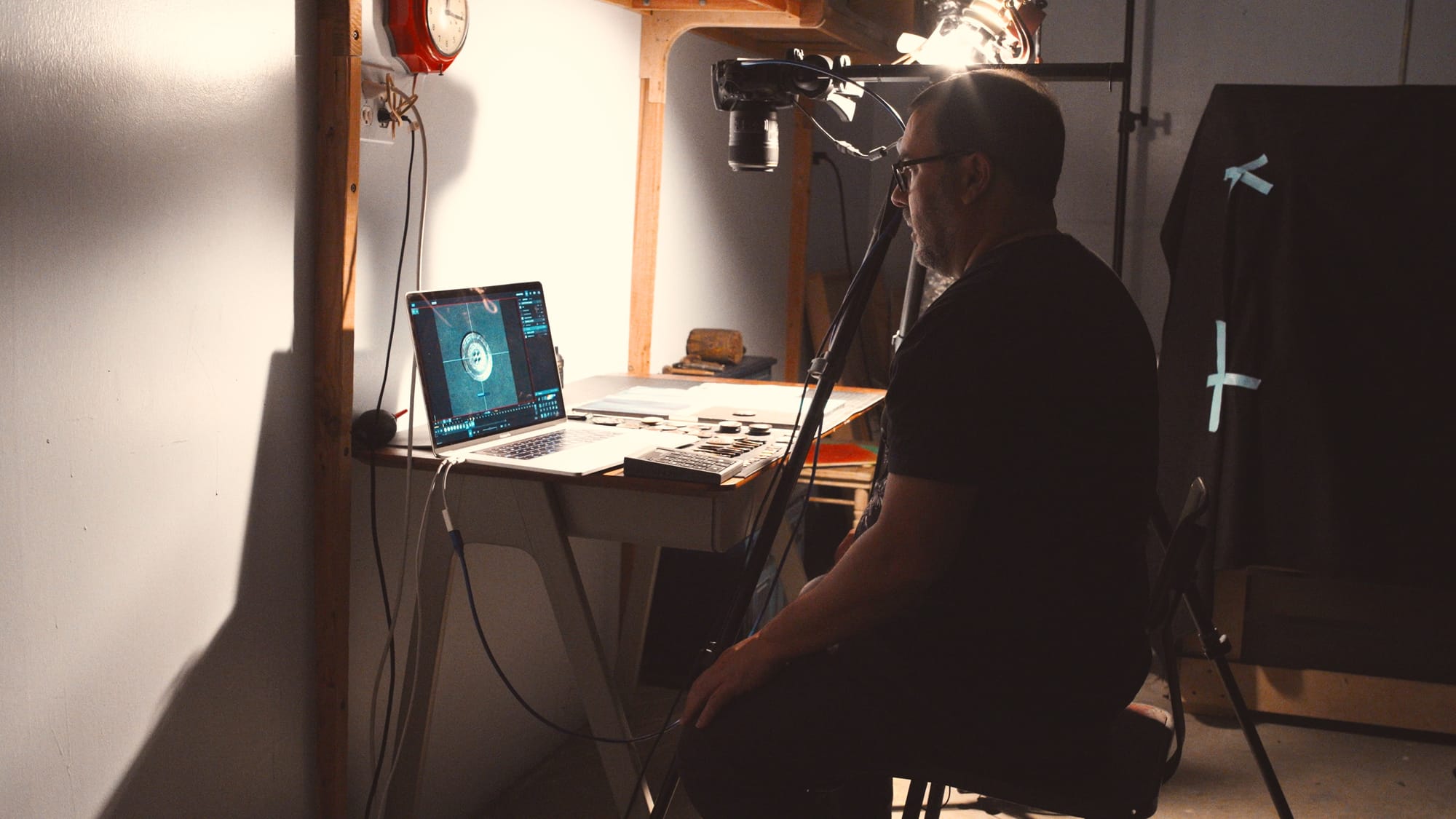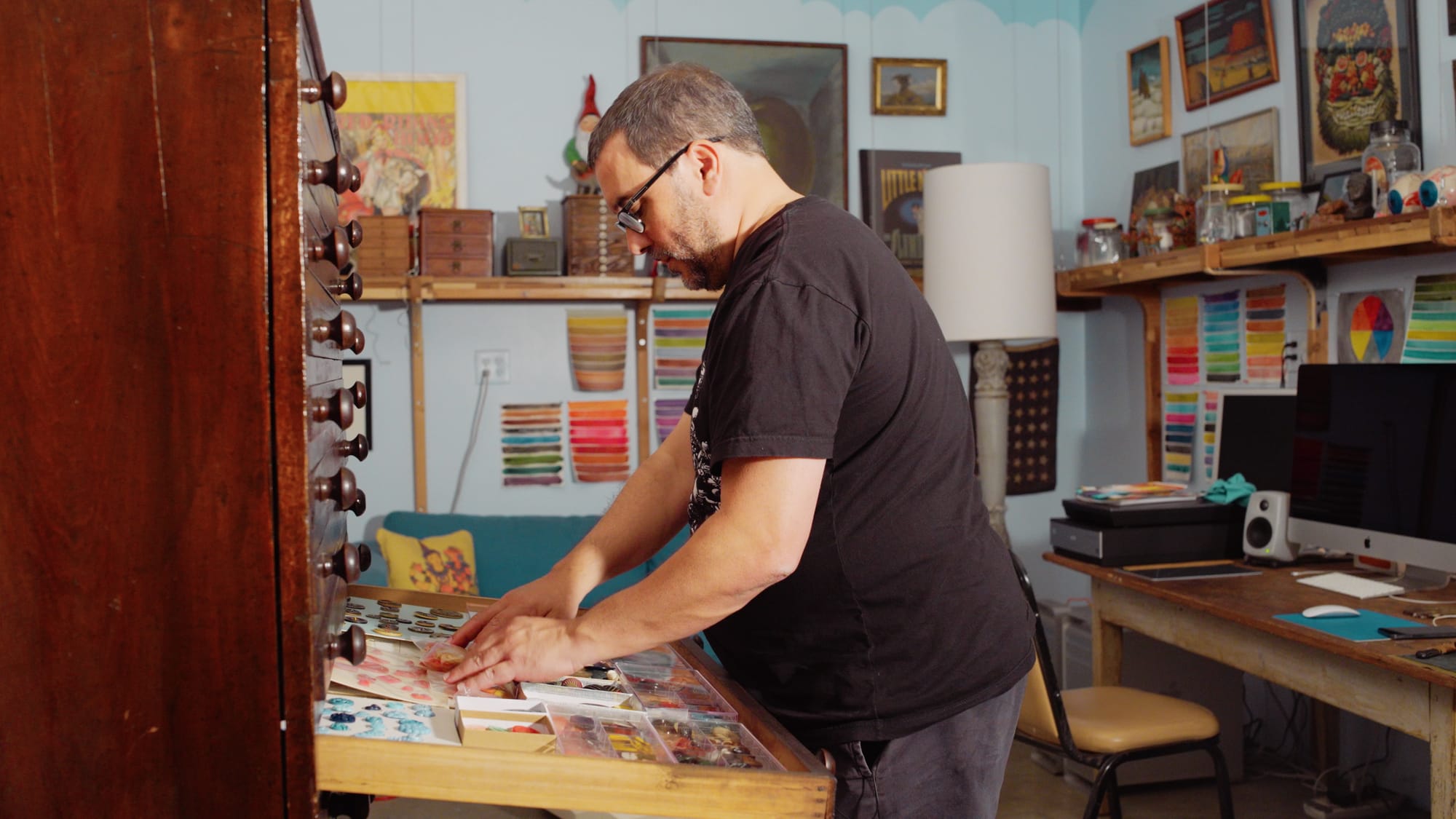Go Inside the Mind of PES: The Stop Motion Animator Making Ordinary Objects Extraordinary
Glimmer creator and stop motion animation artist PES is channeling his creative energy into crafting button collages as part of our Creator Collaboration Series. The hope, he says, is for people to “celebrate the buttons and feel a kinship toward them."

Stop-motion animation artist PES gained acclaim for his ability to transform ordinary items into animated narratives, showcasing a distinctive style in the world of stop-motion animation. He is known for works such as "Fresh Guacamole" - a short film nominated for an Academy Award in 2013 - where he transforms familiar objects into a deliciously unexpected guacamole recipe and "Western Spaghetti," a playful culinary adventure.
PES is now channeling his creative energy into crafting button collages using stop motion animation. The hope, he says, is for people to “celebrate the buttons and feel a kinship toward them."
We've teamed up with PES for our Creator Collaboration Series, a journey into the richness of human creativity. Through this series, we're exploring the fresh perspectives of creators worldwide, learning about their craft, and exploring what "glimmer" means to them. Each artist, including PES, interpreted "glimmer" through their unique medium.
PES, in this interview, shares his early influences, how he expresses himself through stop motion, the power of ideas, and, of course, his current obsession with buttons of all colors, shapes, and sizes.
Shivan: You were very artistic growing up. Who were your early inspirations as a visual artist?
PES: My idols are writers and artists. These are people I looked up to for inspiration. I studied James Joyce, Edgar Allan Poe.
William Blake is another influence of mine when I was in college. William Blake was an interesting figure because he made his own books completely apart from any traditional bookmaking process. He figured out his own way to printmake and communicate his ideas. He invented his own form of printmaking that would allow him to show words and images in these beautiful books. He was this genius who was working in his own little cave and came up with these extraordinary things, which we now value quite deeply. So, there’s something you take from every artist.
Shivan: How did these artists influence your approach to animation?
PES: It speaks to the things that influenced me as a young, growing child, but also as a student were ideas, thinkers, people who expressed themselves in a compelling way. What it shows is that I idolized people of ideas. That's what I aspired to.
I didn't know anything about filmmaking or animation when I was a kid. And I didn’t go to school for animation. It was all about art for me. So, I experimented a lot with all different kinds of materials. I learned how to do color pencils, watercolors, and oil painting. I was painting all the time, and trying to learn what I could by mirroring famous artists, whether that was Winslow Homer, Picasso or Dali. I would try to work in their style using whatever tools I had at the time. And that's really how I learned to express myself as a visual artist.

Shivan: Why didn’t you become a painter?
PES: I often found that I was frustrated – my painting didn't equal what I wanted it to in my head. I was frustrated in that I knew I was a good artist, but wasn’t great. I hadn't found my medium.
More than that, I discovered that I didn't love sitting there all day drawing or painting. It wasn't something that I disappeared into. And you needed to have that in order to be a visual artist for life.
It took me a while to learn that I was more intrigued by the results I was having than with the process. So, when I discovered stop motion animation, it was a revelation for me because I could just grab an object and photograph it. I didn't have to spend any time worrying about whether or not that object was going to look good. It was just going to be the object because it's a photographic medium. It relieved me from all the stress and frustration I found as an artist. I had found this medium where I could take any object and focus on bringing it to life.
Shivan: How would you describe stop motion animation?
PES: It's an incredibly vast and open-ended medium because literally anything that you put in front of the camera and move one frame at a time is considered stop motion animation. It could be sand, it could be Legos, it could be people, it could be wool. Anything that you could dream up to put in front of the lens and move is stop motion animation.

Shivan: What excited you most about stop motion animation?
PES: I really like taking familiar objects and then transforming them through stop motion animation.
I like touching things. I like objects. I like real stuff. There's a certain physicality. I like going to flea markets. I like seeing what people make. I like finding things. I think I'm a little bit of a treasure hunter – I like digging through piles of things and finding something that I might make use of. And so I think that just naturally led me to stop motion where I could put my energy into what I did with these objects that I found or collected.
I followed that instinct. And that led me further and further into this. I just first started making films with the objects that I found. And a lot of times these objects are just cheap things. They're not valuable objects. I've made films with peanuts. It’s just a simple object. But what can you do with it? And so I like the medium because of that. It becomes more about what you can do with things than actually just replicating a peanut, or an object that you've chosen. What I love about this medium is that it's whatever life you can breathe into an object.
Shivan: What objects do you gravitate towards animating?
PES: I like to animate and bring things to life that were never meant to be brought to life. For instance, I see a certain class of objects like clay, puppets, and Legos. These are objects that were essentially meant to be built with or used for creative purposes. I like to take junk. I like to take things that we would normally throw out, whether that is rubber bands, pencils or buttons and do something with them that people haven't really seen before.
I've sort of committed myself to getting these weird ideas out into the world.
Shivan: How did animation allow you to fully express yourself?
PES: I have a lot of ideas in my life. So, it became how to express them. If they’re just ideas then they sit in a notebook and disappear. I began a process of how to express those ideas. It’s really me sharing a bit of what captures my attention or amuses me.
I could express this idea to someone, and they'll be like, ‘This guy is a loony. This sounds like the stupidest idea I have ever heard.’ For instance, two chairs having sex on a New York City rooftop sounds ridiculous.
My first animated film was called “Roof Sex” where I took the two life-size chairs up to a roof in New York City. They escape up there and they have sex. Then grandma comes home and discovers her chairs are all ripped up, and she blames the cat.
Whenever I told people this idea before I made it, they thought I was crazy. They were like: ‘You're going to quit your job in advertising to go make these two chairs have sex on a rooftop?’ And, I said, ‘yes’ because the only way for me to express that idea was to actually do it. So, I had to quit. I needed the time to be able to animate that during the day. I had to teach myself how to animate 'cause I didn't go to school for this. It was really all about trying to express this idea that no one could understand on paper. I made a one minute and ten second film and millions of people saw it.
Shivan: You were one of the pioneers of short-form digital content. What do you think is the power of this format?
PES: From the beginning, I’ve been making short content that was memorable and even re-watchable. And that my perspective on some of my early work was that culture was moving in more of a short content direction. And I believed in that. So I was making one minute films, even when people said I was ridiculous. Then, I came back and made 10-second films, and they were like, ‘That’s even crazier. Who would watch a 10-second film? You can’t even call it a film if it’s 10 seconds long.’
Then eventually with all the social media platforms, it's all about short content. I feel like I was there at the beginning of that. But for me, it was just being able to express my ideas in micro content.
For me, it's fun because I get to envision this thing that everyone else can't imagine.

Shivan: Your current obsession is with buttons. What intrigues you about them?
PES: I've worked with tons of different objects in my life. I used candy corn a lot. Peanuts, Post-it Notes, rubber bands, grenades, everything. I've been shooting pencils over the years, and did some experiments. But, there was something lacking there for me. And the further I thought about it, I realized that buttons are this interesting object because they're like a found art. Each button, as humble as it is, can be quite beautiful. And some of them are hand sculpted, and even when they're not, they represent a history of design throughout the last 120 years.
Also, people keep buttons. They're attached to them. They think that there's some utility to them, but they also, I would argue, have an affection for buttons as an object in general.
Shivan: Do you have a personal attachment to buttons?
PES: One of my earliest buttons memories is of my great Italian aunts in their apartment. They were seamstresses and they would make me my Halloween costumes every year by hand. But they also kept a cookie tin filled with buttons that I would go through. They were probably making ravioli right next to me on the table. But, I was in the button jar, and I have very fond memories of that time in my life. You never know how an object sticks with you.
PES's creative vision was to express Glimmer's icon through button goggles.
Shivan: Can you tell us about your hero piece in collaboration with Glimmer?
PES: I've been working tirelessly making these things I call button collages, trying to bring some life into all these different forms of buttons I've collected. My creative vision was to translate the Glimmer icon and express it through button goggles, as if you were seeing the world through buttons. In particular, seeing the Glimmer logo through buttons.
Shivan: What do you hope to convey to audiences through this work?
PES: The goal is to celebrate this class of hand-carved fresh water buttons I collected and bring them to life in an unexpected way.
It's about bringing a little bit of animation into them. We're not talking about revolutionary things here. We're talking about a little spinning, moving. But we're just trying to bring life into this object that's normally static. And to celebrate it so that the world can appreciate the diversity of these buttons, the beauty of them in a different way.
The hope is when people see these things, they can feel a kinship and connection to the centuries of human creativity that’s led to their creation.
Shivan: Why do you continue, what keeps you going?
PES: Because I'd be miserable if I didn't do it. I've figured out a way in which I can make things that excite me and I can put into the world that other people could maybe get something from.
